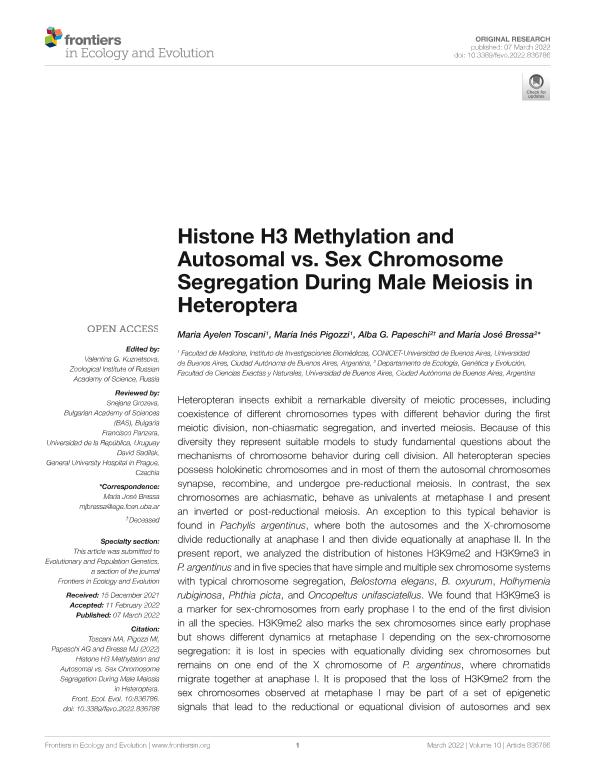Artículo
Histone H3 Methylation and Autosomal vs. Sex Chromosome Segregation During Male Meiosis in Heteroptera
Fecha de publicación:
03/2022
Editorial:
Frontiers Media
Revista:
Frontiers in Ecology and Evolution
ISSN:
2296-701X
Idioma:
Inglés
Tipo de recurso:
Artículo publicado
Clasificación temática:
Resumen
Heteropteran insects exhibit a remarkable diversity of meiotic processes, including coexistence of different chromosomes types with different behavior during the first meiotic division, non-chiasmatic segregation, and inverted meiosis. Because of this diversity they represent suitable models to study fundamental questions about the mechanisms of chromosome behavior during cell division. All heteropteran species possess holokinetic chromosomes and in most of them the autosomal chromosomes synapse, recombine, and undergoe pre-reductional meiosis. In contrast, the sex chromosomes are achiasmatic, behave as univalents at metaphase I and present an inverted or post-reductional meiosis. An exception to this typical behavior is found in Pachylis argentinus, where both the autosomes and the X-chromosome divide reductionally at anaphase I and then divide equationally at anaphase II. In the present report, we analyzed the distribution of histones H3K9me2 and H3K9me3 in P. argentinus and in five species that have simple and multiple sex chromosome systems with typical chromosome segregation, Belostoma elegans, B. oxyurum, Holhymenia rubiginosa, Phthia picta, and Oncopeltus unifasciatellus. We found that H3K9me3 is a marker for sex-chromosomes from early prophase I to the end of the first division in all the species. H3K9me2 also marks the sex chromosomes since early prophase but shows different dynamics at metaphase I depending on the sex-chromosome segregation: it is lost in species with equationally dividing sex chromosomes but remains on one end of the X chromosome of P. argentinus, where chromatids migrate together at anaphase I. It is proposed that the loss of H3K9me2 from the sex chromosomes observed at metaphase I may be part of a set of epigenetic signals that lead to the reductional or equational division of autosomes and sex chromosomes observed in most Heteroptera. The present observations suggest that the histone modifications analyzed here evolved in Heteroptera as markers for asynaptic and achiasmatic sex chromosomes during meiosis to allow the distinction from the chiasmatic autosomal chromosomes.
Archivos asociados
Licencia
Identificadores
Colecciones
Articulos(IEGEBA)
Articulos de INSTITUTO DE ECOLOGIA, GENETICA Y EVOLUCION DE BS. AS
Articulos de INSTITUTO DE ECOLOGIA, GENETICA Y EVOLUCION DE BS. AS
Articulos(INBIOMED)
Articulos de INSTITUTO DE INVESTIGACIONES BIOMEDICAS
Articulos de INSTITUTO DE INVESTIGACIONES BIOMEDICAS
Citación
Toscani, María Ayelén; Pigozzi, Maria Ines; Papeschi, Alba Graciela; Bressa, Maria Jose; Histone H3 Methylation and Autosomal vs. Sex Chromosome Segregation During Male Meiosis in Heteroptera; Frontiers Media; Frontiers in Ecology and Evolution; 10; 3-2022; 1-17
Compartir
Altmétricas




